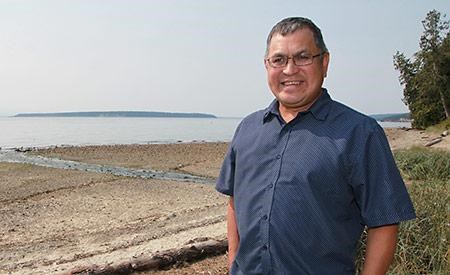While the Tla’amin (Sliammon) Nation’s land transfer under its treaty is nearly two years away, extensive planning for the future is already underway.
The federal government, the last signatory to the treaty, passed its legislation on April 28 of this year. However, it will take nearly two years from that date to complete the process.
Roy Francis, chief negotiator for Tla’amin in the treaty process, and also president of the Sliammon Development Corporation, has been passionate about economic development throughout this region for many years. He is excited about the prospects the treaty brings for the Tla’amin people.
“It seems we’re building a whole new nation out of Sliammon and its very exciting times,” he said.
Tla’amin is one of the first communities in British Columbia to complete a treaty, Francis said.
“We’ve reached agreement with Canada and BC and that agreement had to be approved by all three parties,” he said. “Sliammon’s way of approving the treaty was through a community vote in 2012. The province approved it through passing of legislation. The federal government is the most recent to approve the treaty. So, now it’s about implementing the treaty.”
Francis said preparations are being made for the day the treaty comes into effect.
“The effective date is in April of 2016,” he said. “The work that is in play now is making all the preparations for that effective date.
“Land, for example, is one of the elements of the treaty. Before the treaty we had just less than 2,000 hectares of land that is Indian reserve. After effective date it is going to grow to 8,000 hectares of land. Some of the work now is making those preparations for that land transfer.”
Francis said some of that effort involves surveying the additional lands. Then, there will be the registration of those lands in the provincial land title office.
“At effective date those lands transfer as provincial Crown to become Sliammon fee simple lands,” he said. “This process is a massive undertaking.
“A minute after midnight on April 5, 2016, lands get registered. It’s a massive toll on the registration system for those lands to be registered as Sliammon lands.”
New laws will also be coming into effect under the treaty.
“Sliammon will have lawmaking authority in a range of areas,” Francis said. “Sliammon will be a taxation authority and will be levying its own property taxes and income taxes.”
Another area of concentration is land-use planning. A land-use plan is just being completed, he said. There will be 6,000 new hectares of land added to the existing reserve land so there is preparatory and developmental work looking at how the first nation plans to make use of those lands.
Some of the planning will be complementary. The Powell River Regional District is currently working on an Official Community Plan (OCP) in its Area A region north of Powell River. Area A lands and Tla’amin lands are intermingled throughout the region north of the City of Powell River.
“We’ve built a good working relationship with the regional district,” Francis said. “We’ve also built a good relationship with the City of Powell River for that matter.”
Some of those areas of new land will be designated community-use lands. As Tla’amin and its population grows, the first nation will be providing housing and a land base for growth. There are going to be other areas of land identified for economic or commercial development.
The first nation currently has subdivisions where land is leased long term to tenants. “We are going to be looking at that idea and perhaps developing further residential areas like we have in Klahanie and Southview,” Francis said.
Land-use planning will be projected long term. “I think over the years we’ll see residential developments, mixed-use developments, commercial developments, so life is very, very busy for us now in that planning world,” Francis said.
The Tla’amin land base will be larger than that owned by the City of Powell River.
An exciting development is the construction of a new government house, which will serve as the administration building for Tla’amin Nation.
“The grounds are being prepared now and the construction should be underway in the next few months.”
Tla’amin certainly occupies a leadership role among first nations, he said, adding only a handful of BC first nations have completed treaties.
“I think one of the things that brought us to this place of recommending a completed treaty is there has been a lot of economic development context in the background,” he said. “Having to wrestle with significant parts of it—the land base for example—a question emerges: why would our community entertain 6,000 hectares of land? The response to that is 6,000 hectares of land has huge value and we can put some of those lands into a development perspective. We can use those lands to generate good returns for our nation. It can be a stepping stone to expanding our land base, generating money to leverage more land.”
The process of finalizing the treaty was not rapid.
“It’s pushing toward 20 years since the beginning,” Francis said. “It has been a long, drawn-out negotiation. There were points, and there still are points where we are not completely happy, but overall, it’s a lot better than what we had before.”
Tla’amin is building on what is already in place. Francis said the first nation owns a hotel, a forestry company and aquaculture interests.
“It’s coming along nicely,” he said. “We’re making slow, careful steps and we’ll do well.”
With the treaty in place, Francis sees the next 20 years as being better.
“We have a lot of work in front of us and we are in a good place to be building. We are building a community and that involves all of our community members.
“We are preparing our members, getting people off to colleges, universities and trades. We are redesigning and reinventing our identity. It’s an amazing place to be.”



